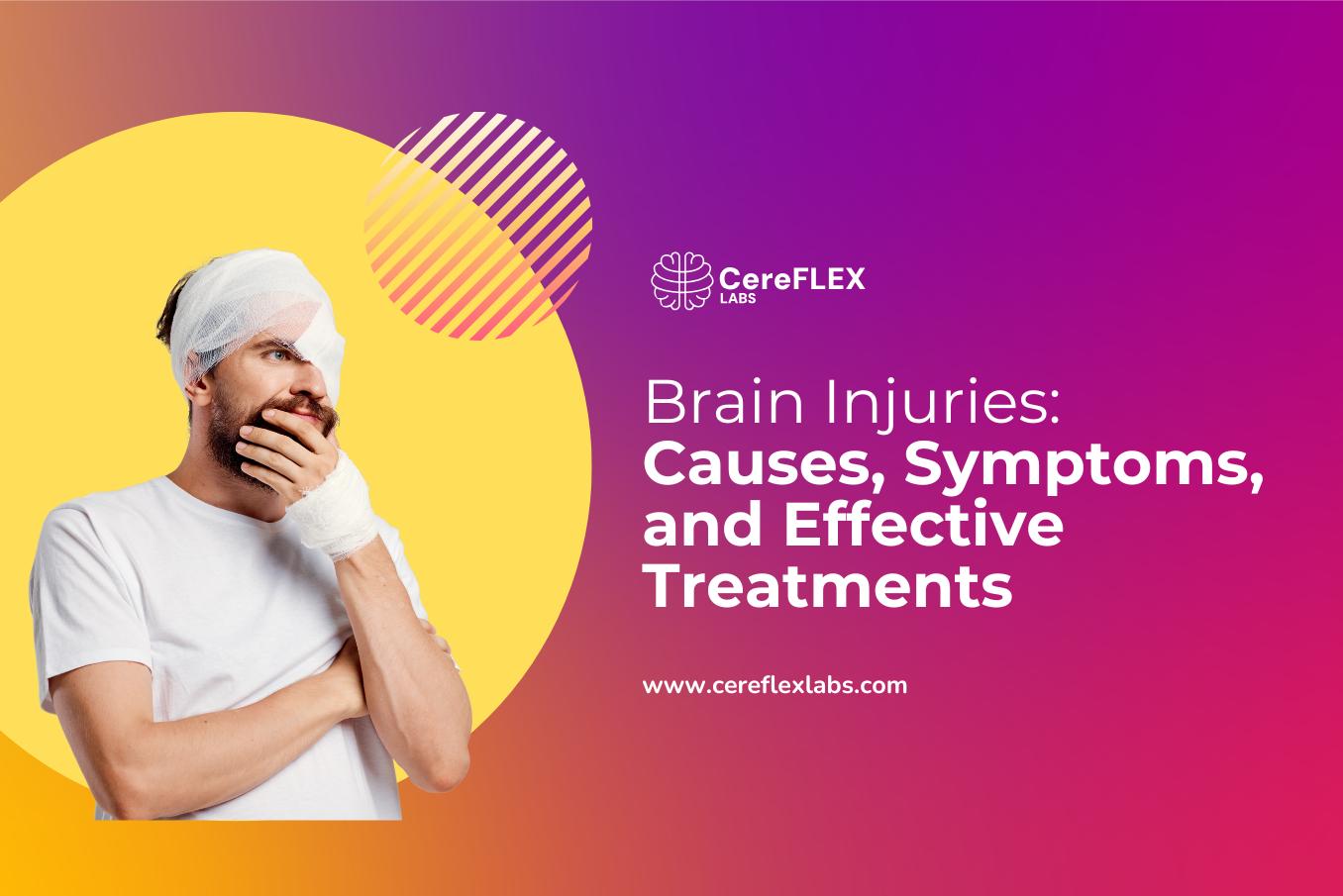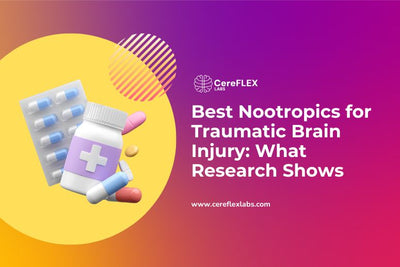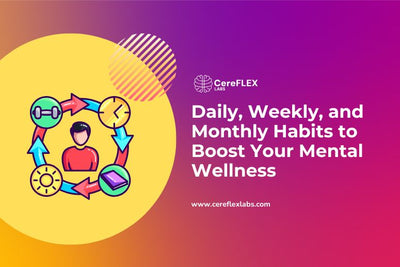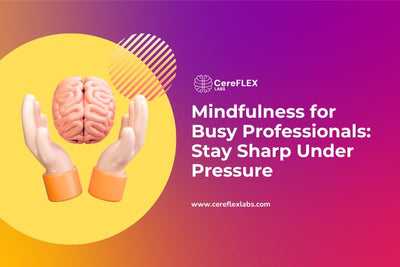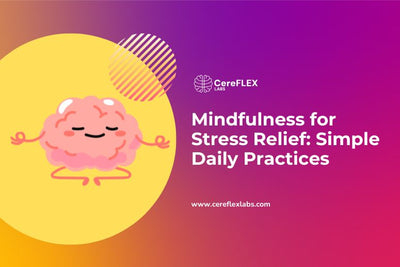Living with a brain injury is like working on a jigsaw puzzle with missing pieces. You can see the picture it’s supposed to form, but completing it feels frustrating and incomplete. From disrupted routines to challenges with memory or mood, the impact runs deeper than you might think.
At CereFLEX Labs, we get it. Brain injuries don’t just affect individuals—they ripple through families and communities. This guide is here to break things down: what causes brain injuries, how to spot the signs, and the best ways to treat them. Let’s dive into practical insights that could make all the difference for you or someone you care about.
Here is the Quick Answer |
|
Brain injuries—from concussions to strokes—can impact memory, mood, and daily life. Early recognition of symptoms like confusion or headaches is key. Treatment includes medical care, rehab, and support from solutions like CereFLEX to aid recovery and boost cognitive health. Prevention, awareness, and holistic healing all play vital roles. |
Understanding Brain Injuries: What, Why, and Who?
Understanding brain injuries opens the door to better care and recovery. They can affect anyone, from athletes to accident survivors, requiring both medical support and lifestyle changes.
Gaining cognitive insights and wellness along the way can help uncover strategies for a healthier future.
Let’s unpack what brain injuries are, why they happen, and who faces the highest risks to give you a clearer path forward.
What are brain injuries?
Think of your brain as a supercomputer. A brain injury is like spilling coffee on the keyboard—everything slows or misfires. These injuries can be:
- Traumatic: Caused by external forces like falls or car accidents.
- Non-Traumatic: Resulting from internal issues like strokes or infections.
They range from mild concussions to severe conditions like diffuse axonal injuries (where brain cells stretch or tear). Even minor impacts can create long-lasting challenges if untreated.
Why do brain injuries happen?
Brain injuries don’t play favorites. Here’s a look at some common causes:
- Accidents: Slips, trips, and collisions are major culprits.
- Sports Injuries: Football, hockey, or even cycling can lead to frequent concussions.
- Medical Conditions: Strokes or brain tumors can cause significant damage.
Who’s most at risk?
While anyone can experience a brain injury, these groups face higher risks:
- Athletes: Especially those in high-impact sports.
- Accident Survivors: Car crashes often lead to head trauma or whiplash.
- Military Personnel: Combat exposure increases vulnerability.
By understanding the “why” and “who,” you’re better equipped to recognize risks and seek help early.

Can children’s brain injuries affect them later in life?
Absolutely. Even mild injuries in children can impact cognitive development, behavior, and learning abilities as they grow.
Recovering from a brain injury can feel overwhelming, but here’s the good news: You’re not alone. At CereFLEX Labs, we’re here to simplify your journey with science-backed solutions and expert care. From supporting memory and cognition to protecting cells from free radical damage, our products are crafted with your neurological health in mind.
Ready to take the next step? Explore how CereFLEX can support you or your loved one today. Because your brain deserves nothing less than the best care.
Recognizing Symptoms of Brain Injuries
Sometimes, brain injuries hide in plain sight. Here’s how to spot the signs:
Physical Symptoms
- Headaches or persistent dizziness
- Sensitivity to light or noise
- Nausea or fatigue that lingers
Cognitive Symptoms
- Memory gaps (like forgetting names or tasks)
- Trouble concentrating or slower thinking
- Confusion, especially in routine situations
Emotional Symptoms
- Mood swings or irritability
- Anxiety or a sense of hopelessness
- Depression that feels hard to shake
Early Recognition Matters!
Think of these symptoms as your brain’s SOS signals. Ignoring them can lead to bigger problems down the road. At CereFLEX Labs, we advocate for early intervention—it’s the first step to healing.
Effective Treatments for Brain Injuries
Treating brain injuries isn’t a one-size-fits-all approach. It involves understanding the severity of the injury, tailoring therapies, and embracing holistic methods. By combining medical care, rehabilitation, and support from innovative solutions such as supplement protocols, recovery becomes not just possible but achievable.
Step 1: Seek Immediate Medical Help
If there’s head trauma, don’t delay. Doctors can assess damage using CT scans or MRIs, and in severe cases, they’ll reduce pressure inside the skull to prevent further harm.
Step 2: Rehabilitation is Key
Recovery takes teamwork and time:
- Physical Therapy: Helps rebuild strength and balance.
- Occupational Therapy: Supports relearning daily tasks like dressing or cooking.
- Cognitive Therapy: Sharpens memory and problem-solving skills.
A review on cognitive rehabilitation for traumatic brain injury (TBI) shows personalized strategies, such as memory exercises and attention training, significantly improve recovery and boost mental clarity over time.
Step 3: The CereFLEX Advantage
This is where CereFLEX Labs steps in. Our products are designed to support neurological health from the inside out, focusing on metabolic optimization. Instead of juggling multiple supplements, our streamlined solutions provide targeted nutrients to help maintain brain function, all in an easy-to-follow routine.
Step 4: Holistic Healing
Brain health thrives on balance. For those aiming to boost cognitive longevity, these habits can make a world of difference:
- Nutrition: Fuel your brain with whole foods and hydration.
- Exercise: Even light activity boosts blood flow and healing.
- Mindfulness: Techniques like meditation reduce stress and support emotional resilience.
Research shows that adding nutrients like Omega-3s, antioxidants, and polyphenols early in recovery can work wonders, reducing inflammation and supporting the brain’s natural healing process.

Addressing Myths About Brain Injuries
Brain injuries come with a lot of misinformation. Let’s clear the air:
Myth 1: Brain injuries only happen from major impacts
Truth: Even minor bumps or jolts can cause brain injuries, like concussions. It’s not always about high-impact accidents; everyday incidents can have significant effects.
Myth 2: Brain injuries heal quickly
Truth: Recovery varies. Mild injuries might improve in weeks, but severe ones may require ongoing care. That’s where CereFLEX products help enhance memory, cognition, peripheral circulation, and support the fight against the oxidative effects of free radical damage.
Myth 3: Children recover from brain injuries faster
Truth: Children may show fewer immediate symptoms, but their developing brains are still vulnerable, and the long-term effects can be significant.
Myth-busting empowers you with the knowledge to act confidently and responsibly.
Conclusion: Healing with Hope and CereFLEX
Recovering from a brain injury can feel overwhelming, but here’s the good news: You’re not alone. At CereFLEX Labs, we’re here to simplify your journey with science-backed solutions and expert care.
From reducing brain fog to improving memory, our products are crafted with your recovery in mind. We provide an excellent way to boost brain performance and regain mental clarity.
Ready to take the next step? Explore how CereFLEX can support you or your loved one today. Because your brain deserves nothing less than the best care.
FAQ
1. Can a person fully recover from a brain injury?
Recovery depends on the severity of the injury. While some mild injuries heal completely, moderate to severe injuries often require long-term care and rehabilitation.
2. How can I support a loved one with a brain injury?
Be patient and understanding. Encourage them to follow medical advice, participate in therapies, and consider holistic approaches like proper nutrition and mindfulness.
3. Are there preventive measures for brain injuries?
Yes, wearing helmets during sports, using seat belts in vehicles, and creating fall-proof environments at home can reduce the risk of brain injuries.
4. Do brain injuries increase the risk of other conditions?
Yes, brain injuries can increase the risk of conditions like depression, anxiety, and even neurodegenerative diseases like Alzheimer’s over time.
